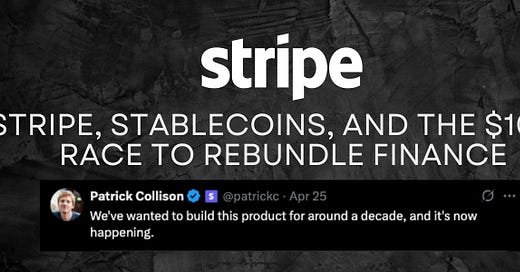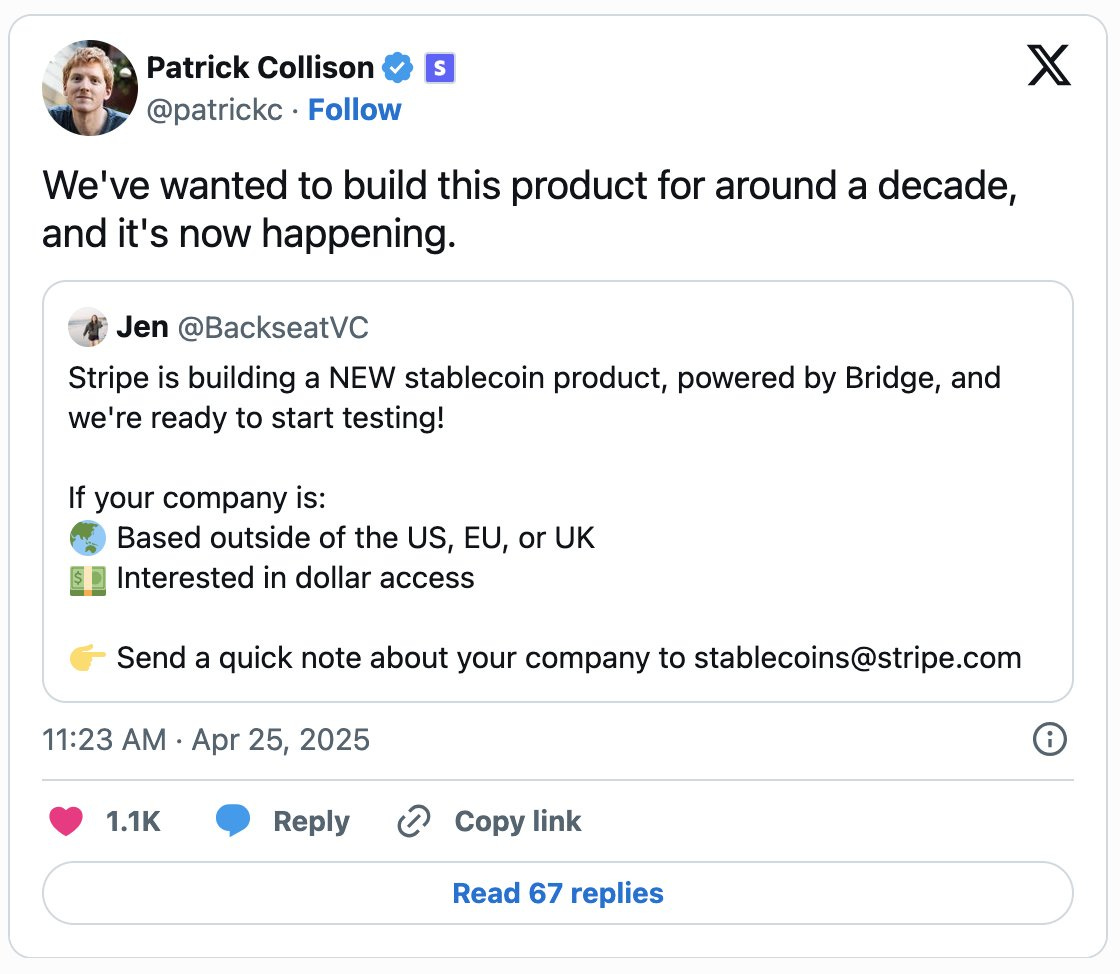Stripe, Stablecoins, and the $100B Race to Rebundle Finance
Stripe’s new product is only the opening move. Acquirers, wallets, and fintechs are racing to capture deposits, payments, and relationships - reshaping the global financial system.
1. Introduction
In an industry defining move, Stripe just announced a pilot of its new stablecoin product. Powered by its $1.1 billion acquisition of Bridge, this new product appears to enable businesses outside the U.S., U.K., and EU to hold, send, and receive natively via stablecoins. Patrick Collison, Stripe’s CEO, noted that this vision had been in the works for nearly a decade.
However, this is more than just a new product — it’s the beginning of a fundamental realignment of financial services.
Stablecoins have unbundled the traditional bank account, stripping it down to its essential primitives: hold value and move value. In doing so, they are opening the door for acquirers, wallets, and fintechs to rebundle financial services, this time, rebuilt around programmable, global, on-chain money.
Control over deposits, payments and the end user relationship is up for grabs. Whoever captures this shift will build the next $100 billion financial giants.
Let’s break down how this is happening.
2. Merchant Acquirer Shift: Banking Without Banks
Traditionally, a merchant acquirer’s job was simple: help businesses accept card payments. Everything else, holding deposits, offering FX services, providing treasury tools, was the domain of banks.
Even fintech pioneers like Stripe historically needed partner banks to offer settlement accounts. Stripe recently sought a limited banking license to streamline parts of its backend operations, but notably, this did not cover taking deposits directly.
Stablecoins blow this open.
Now, with stablecoin wallets, Stripe, MoonPay, and others can offer businesses:
Global dollar accounts / Multi-currency treasury
Instant cross-border payments
Embedded yield by passing through returns from tokenized assets
They can then layer on top seamless financial workflows like billing, payouts, and spend management. The merchant dashboard can become the primary banking interface.
For businesses operating in volatile-currency markets, the appeal is even stronger. Offshore dollar accounts can be hard to come by, and stablecoin rails offer this dollar stability, better access to global markets, and dramatically lower costs for cross-border transactions.
This shift opens up merchant acquisition opportunities in vast new territories where traditional banking penetration has been thin or expensive.
3. Issuer Disruption: Wallets Become the New Banks
While acquirers move upstream into merchant banking, consumer wallets are quietly becoming the new banks for individuals.
Traditionally, banks captured deposits by offering consumers basic services: a checking account, a debit card, maybe a small interest rate on savings. Deposits were cheap, sticky funding sources, and banks spent little effort improving the customer experience (hence the rise in UX focused neo banks such as Chime).
But today’s fintech apps offer much more.
Already, wallets like Revolut, Cash App, Venmo, and crypto exchanges like Kraken, OKX, and Coinbase are increasingly capturing consumer balances and combining holding, investing and payments (see Kraken Pay launch and OKX Pay launch). In Asia, WeChat Pay and Alipay proved that wallets could dominate daily financial life.
Now, stablecoins are supercharging this trend. Wallets can:
Receive payroll
Issue cards tied to stablecoin balances to enable direct spending without converting to fiat
Enable P2P payments globally
Offer yield via tokenized money markets
This continues an existing trend: the wallet becomes the financial hub — no bank branch needed.
The key is distribution and user experience. Consumers won't switch to a bank because it’s regulated. They’ll stay with the app that helps them hold, save, spend, invest, and send money, seamlessly, globally, and cheaply.
Stablecoins give fintechs the foundation to own the core banking relationship, without becoming banks themselves.
4. Enablers: Why Now?
Several critical factors have aligned to make this realignment possible:
Growing trust and familiarity: Stablecoins have become widely trusted by consumers, businesses, and developers. With a $230 billion market cap and daily usage across financial applications, familiarity is steadily increasing.
Maturing infrastructure: Liquidity depth and corridor availability have all advanced significantly. A growing network of on/off ramps, settlement APIs, and blockchain orchestration tools are increasingly enabling near instant global payouts.
Access to yield: Stablecoin products can seamlessly offer instant savings and money market yields to users, in an easily composable way.
Compliance tooling: Embedded KYC, wallet screening, and Travel Rule compliance are rapidly maturing, allowing fintechs to operate securely and legally across multiple jurisdictions.
Emerging regulatory clarity: In the U.S., stablecoin legislation is moving quickly and banking regulators (OCC, FDIC, Federal Reserve) have provided positive guidance. MiCA is live in the EU, and other markets have developed or are developing clear frameworks for issuance and stablecoin-enabled payments innovation (Singapore, Hong Kong, UAE). As regulatory clarity improves, large enterprises and financial institutions are starting to view stablecoins as viable tools for treasury, payouts, and savings.
Bottom line: The tech, the market education, and the regulatory momentum are aligning.
5. Market Structure: The Great Rebundling
Stablecoins enable a rapid rebundling of adjacent financial services.
Here’s how the new market will likely organize:
Merchant Acquirers → Global Merchant Banks: Stripe and MoonPay have made the first moves — moving from “accept payments” to “run your entire treasury.”
Exchanges/Consumer Wallets → Consumer Banks: Wallets (Revolut, Cash App, Paypal, Venmo) and Exchanges (OKX, Kraken, Coinbase) are capturing balances, adding cards and enabling spend, savings and payments. Robinhood has already launched a credit card and is adding a checking and savings account. They have been vocal about leveraging stablecoins more.
Card Networks → Stablecoin Settlement and Infrastructure: Visa and Mastercard are recasting themselves as the bridge between TradFi and on-chain money. Visa’s USDC settlement pilots and Mastercard’s suite of stablecoin capabilities, enable same-day stablecoin payouts to merchant processors. Both schemes now support stablecoin-funded cards, keeping the networks indispensable while money moves on-chain. Through Visa Tokenized Asset Platform (VTAP) and Mastercard's Multi-Token Network (MTN) both firms are also positioning themselves as trusted infrastructure for banks and financial institutions, going beyond payments.
Banks → At Risk: Traditional banks have existing distribution but they must improve their offerings to meet rising customer standards, or risk becoming disintermediated. Business banking is often local and relationship driven so it’s not that simple, but the trend doesn’t bode well.
Interestingly, companies like Paypal, Block and now Moonpay already have both merchant and consumer businesses and can, to an extent, play the role of the networks themselves. They can do some of this already today (e.g. Cash app is accepted on Square point-of-sale terminals), but better financial infrastructure enables this globally.
As for stablecoin issuers, diversification away from solely issuance is necessary and already underway.
@Circle recently launched a payment network, aiming to monetize trust, coordination and their distribution.
Tether has backed the stablecoin dedicated blockchain @PlasmaFDN
which could be the settlement layer for a range of stablecoin enabled services.
@Paxos already offers a range of enterprise infrastructure solutions for brokerage, custody and money movement.
The financial system of 10 years from now could look drastically different.
6. Who Builds the Next $100 Billion Giants?
The winners will likely share two critical traits:
They own distribution — directly with merchants, consumers, or both.
They seamlessly integrate stablecoin rails — enabling programmable money movement, yield, treasury, and embedded finance direct to the end user or in the background as better financial plumbing.
Those who cling to the old models will likely lose share.
Stablecoins are the new operating system for money.
Those who master this new stack will win much more than just payments.
It’s a land grab for distribution, and it’s only just beginning.




